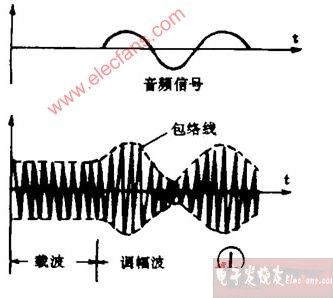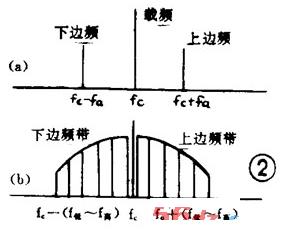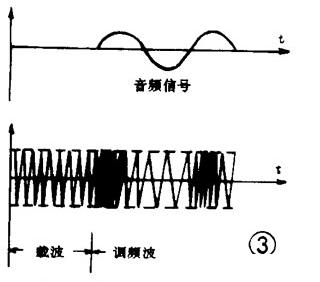AM broadcast and FM broadcast
With the improvement of living standards, people are no longer satisfied with radios that can only listen to medium-wave AM broadcasts. When purchasing radios, products with both FM and AM functions are required. So why do radio stations broadcast in two different ways: FM and AM? What are the characteristics and differences between FM and AM broadcasts? Let's talk about this issue.
As we all know, radio broadcasting relies on high-frequency electromagnetic waves in space to broadcast programs. Here, high-frequency electromagnetic waves do not contain any information, and only serve as a "vehicle". Therefore, it is also called carrier wave. Normally, the frequency of the Central People's Broadcasting Station is 540 kHz, and the Shanghai People's Broadcasting Station is 990 kHz, which is the carrier frequency. The frequency of the broadcast program to be transmitted is much lower than the frequency of the carrier, which is between 30 Hz and 15000 Hz, and is called an audio signal or a low-frequency signal. Low-frequency signals are not far away. You must try to superimpose it with the high-frequency carrier to achieve the purpose of remote transmission. This process of superposition is called modulation. In radio colloquium: the process of controlling high-frequency oscillations with low-frequency signals is called modulation.
There are two commonly used modulation methods: when the amplitude of the high-frequency oscillation is controlled, or the amplitude of the high-frequency oscillation changes with the size of the audio signal. This modulation method is called amplitude modulation. If the frequency of high-frequency oscillation is controlled, or the frequency of high-frequency oscillation changes with the size of the audio signal, this modulation method is called frequency modulation.
The characteristic of amplitude modulation is that the frequency of the carrier wave is always the same, and the shape of the carrier wave amplitude change is the same as the shape of the audio signal change. We call the trajectory of amplitude change the envelope. As can be seen from Figure 1, the shape of the envelope is the same as the audio signal. The carrier wave modulated by the audio signal is called modulated wave.

The carrier wave before unmodulation is a sine wave, and the modulated wave is no longer a single sine wave, it is the result of the addition of several sine waves. And it is combined according to some mathematical rules. If a single tone frequency signal fa is used to modulate the carrier frequency fc, the modulated wave can be decomposed mathematically by the addition of 3 sine waves. Its frequency components are: carrier frequency fc; carrier frequency higher than carrier frequency fc plus audio frequency fc + fa, called the upper side frequency; carrier frequency lower than carrier frequency fc minus audio frequency fc-fa, called the lower side frequency. The relative amplitude and frequency relationship of these three sine waves is represented by a graph, which is called the spectrum diagram of the amplitude modulation wave, as shown in Figure 2 (a). If all the frequencies in the entire audio range are used to modulate the carrier, in addition to the carrier frequency in the modulated wave, the upper and lower side frequencies become the upper and lower sidebands. It becomes the spectrogram as shown in Figure 2 (b).

It can be seen from the spectrogram (b) that the frequency width of each sideband is equal to the frequency bandwidth of the audio modulation signal. In other words, the bandwidth of the AM wave is twice the audio bandwidth. For example: to modulate a carrier frequency of 990 kHz with an audio signal of 30 to 15000 Hz, its upper sideband is from 990.03 to 1005 kHz; its lower sideband is from 989.97 to 975 kHz. The frequency range of this modulated wave is from 975 to 1005 kHz. The bandwidth of the modulated wave is 1005 kHz—975 kHz = 30 kHz. In other words, the bandwidth of the AM wave transmitted by the broadcasting station is twice the highest frequency of the audio. In fact, the frequency bandwidth of broadcasting stations is not 30 kHz. The frequency range of medium wave AM broadcasting in China is from 535 to 1605 kHz. If the calculation is based on 30 kHz, only the platform (1605-535) / 30≈36 (seat) can be set. It is impossible for a country as large as ours. In order to prevent neighboring frequency stations from interfering with each other in a limited broadcast frequency band, it is also necessary to set up a larger number of stations, which can only compress the bandwidth of each station. Internationally, the channel spacing for medium wave broadcasting is 9 kHz. That is, the bandwidth of each station is limited to 9 kHz. Therefore, the high audio frequency in the audio signal is limited to below 4.5 kHz. When listening to medium wave AM broadcasts, the treble component feels lacking. This is especially obvious when broadcasting music programs. This is a major weakness of AM broadcasting. In addition, another shortcoming of AM broadcasting is the poor anti-interference ability. Because various industrial interference and natural electricity interference will also be superimposed on the carrier in the form of amplitude modulation, which becomes interference and noise, which affects the listening effect. The characteristic of FM is that the amplitude of the carrier is always the same, and its frequency changes with the size of the audio signal. As shown in Figure 3: When the audio signal is enhanced, the frequency becomes higher and the waveform becomes dense; when the audio signal is weakened, the frequency becomes lower and the waveform becomes thinner. This change in the density of the waveform means that the width of the frequency is changing. We call the width of the frequency change frequency offset, or frequency offset for short. FM broadcast transmits information through frequency deviation.

The frequency spectrum of an FM wave is much more complicated than an AM wave. Its side frequency is composed of many harmonics. In FM broadcasting, the highest frequency deviation is specified as 7 5 kHz, and the frequency bandwidth occupied by each station is 200 kHz [bandwidth = (frequency deviation + audio) × 2, mono is 180 kHz, and stereo is 198 KHz]. Twenty times more than AM broadcasting. Therefore, in FM broadcasting, the high frequency of the audio signal can be expanded to 15 kHz. So FM radio programs sound richer, clearer, and more realistic than AM radio. Especially when listening to stereo high-fidelity music programs, it is unmatched by AM broadcasting.
Another characteristic of FM broadcasting is its strong anti-interference ability. Because the interference mainly affects the amplitude of the carrier wave, it has little effect on the frequency of the carrier wave. Therefore, it is easy to eliminate the interference by using the limiter in the receiver. See Figure 4.

Because the frequency band occupied by the FM radio station is relatively wide, if the medium-wave frequency is still used, then (1605-535) /200=5.35, which can only accommodate 5 radio stations. Obviously unrealistic. Therefore, medium wave and short wave are not suitable for FM broadcasting, and must be moved to the ultra-short wave frequency range. The frequency range of FM broadcasting used in China is 88-108 MHz. Everyone knows that medium and short waves are propagated by ground waves and ionospheric reflections and can be used for long-distance broadcasting. Especially the short waves reflected by the ionosphere can spread all over the world. However, the ultrashort wave meets the ionosphere and only passes through without reflection. It can only propagate directly on the ground. Therefore, FM broadcasting cannot be used for long-distance broadcasting.
FM radio is more complicated than AM radio. In addition to the use of a proportional discriminator to detect waves, high-amplifier circuits and de-emphasis circuits are also required. If you receive stereo sound, you need to use a decoding circuit. The cost is higher than the AM radio.
AM and FM broadcasts have their own advantages and disadvantages, and no one can replace them. Therefore, there are both AM and FM broadcasts and FM ultra-shortwave broadcasts. They will "peace coexist" and "long-term coexistence." The best example of "cooperation" in AM and FM is the TV. Its image signal adopts amplitude modulation method, and its sound signal adopts frequency modulation method. The reason is not repeated here.
10GbE Media Converters transparently connect 10 Gigabit Ethernet links over multimode or single mode fiber. Each 10G Media Converter comes with pluggable transceiver ports that support fiber to fiber, copper to fiber or copper to copper media conversion.10G media converter are complete and versatile solutions for the application such as FTTx, CWDM and carrier Ethernet. By the diversified speeds of 1,000Mbps and 10G, N-net provides standalone 10G media converter products for different applications and can be applied as per your ideal network topology.
N-net 10G media converter supports various interfaces such as UTP, SFP, SFP+, XFP etc. All these interfaces are developed to support the protocols such as 100Base-Tx, 1000Base-T, 10GBase-T, and 10GBase-LR, 10GBase-SR, which makes your network more complete and solid.
10G Fiber Media Converter,Fiber Optic Media Converter,Fiber Optic Converter,Fiber Media Converter
Shenzhen N-net High-Tech Co.,Ltd , http://www.nnetswitch.com